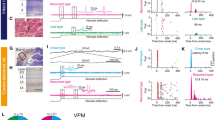Abstract
The influence of the stimulation of the midbrain reticular formation (NRT) at a frequency of 75–100 Hz, current strength 33–400 μA, on the interaction of neurons of the visual and sensorimotor areas of the neocortex of rabbits was investigated. Cross- and autocorrelation histograms of the impulse sequences were plotted. Stimulation of the NRT led to an increase in the number of pairs of neurons functioning in correlation and an increase in the probability of discharges of neurons one after the other with delays from 100 to 400 msec as compared with resting wakefulness. The mechanisms of the interaction of the cells were not altered in the process. Comparison with previously obtained data made it possible to conclude that activation of the NRT may lead to specific changes in the interaction of neurons which are observable during pseudoconditioning and at the beginning of the development of a conditioned reflex.
Similar content being viewed by others
References
O. G. Baklavadzhyan and V. S. Eganova, “The neuronal mechanisms of hypothalamo-reticular influences on the activity of the cerebral cortex,”Uspekhi Fiziol. Nauk,13, No. 2, 3–30 (1982).
N. Yu. Belenkov, “The conditioned reflex and the reticular formation,” in:The Structural-Functional Bases of Conditioned Reflexes. Materials of a Symposium [in Russian], Nauka, Leningrad (1970), pp. 18–35.
N. V. Bobkova, “The influence of coagulation of nuclei of the reticular formation (NRP and NRT) on the level of spatial synchronization of the biopotentials of the neocortex of the rabbit,” Zh.Vyssh. Nerv. Deyat.,29, No. 4, 831–839 (1979).
P. V. Bukh-Viner, I, V. Volkov, and G. Kh. Merzhanova, “The spike collector,”Zh. Vyssh. Nerv. Deyat.,40, No. 6, 1194–1199 (1990).
G. G. Gasanov, Z. G. Mamedov, and N. F. Samedova, “Change in the reactivity of neurons of the visual cortex under the influence of the posterolateral hypothalamus and the nuclei of the midbrain raphé,”Fiziol. Zh. SSSR,74, No. 5, 617–624 (1988).
V. I. Zadorozhnyi, “The reorganization of the mosaic of the activity of neurons of the sensorimotor cortex in rabbits under the influence of nonspecific afferentation,”Zh. Vyssh. Nerv. Deyat.,32, No. 5, 970–972 (1982).
L. V. Kalyuzhnyi and I. N. Zakharova, “EEG data on the interrelationships of the visual area of the cortex, the hypothalamus, the hippocampus, and the midbrain reticular formation during the formation of a temporary connection,” in:The Physiology and Pathophysiology of the Limbicoreticular System [in Russian], Nauka, Moscow (1971), pp. 35–40.
I. N. Knipst, “The spatial synchronization of bioelectrical oscillations of the cortex and some subcortical structures of the rabbit brain during the development of conditioned reflexes,” in:Contemporary Problems in the Electrophysiology of the Central Nervous System [in Russian], Nauka, Moscow (1967), pp. 127–137.
M. N. Livanov, “The mechanism of the activating effect of the reticular formation on the cerebral cortex,”Dokl. Akad. Nauk SSSR,224, No. 6, 1460–1463 (1975).
M. N. Livanov, “The functional significance of some subcortical structures,”Uspekhi Fiziol. Nauk,12, No. 3, 3–21 (1981).
I. V. Pavlova, “The coupling of the impulse activity of neurons of the visual and sensorimotor areas of the neocortex of rabbits in resting wakefulness and pseudoconditioning,”Zh. Vyssh. Nerv. Deyal.,37, No. 5, 850–859 (1987).
I. V. Pavlova,The Interaction of Neurons of the New Cortex in Tonic Conditioned Reflexes [in Russian], Nauka, Moscow (1990).
I. V. Pavlova and V. A. Zosimovskii, “The interaction of neurons of the visual and sensorimotor areas of the neocortex during the development and the extinction of the conditioned defense reflex,”Zh. Vyssh. Nerv. Deyat.,34, No. 4, 710–718 (1984).
I. V. Pavlova and V. A. Zosimovskii, “The types of correlational relationships of the impulse activity of neurons of the visual and sensorimotor areas of the neocortex in rabbits,”Zh. Vyssh. Nerv. Deyat.,37, No. 2, 313–322 (1987).
I. S. Stashkevich and N. V. Veber, “The character of the functional connections of neurons of the sensorimotor cortex in the case of isolated and combined stimulations of the thalamic nuclei,”Zh. Vysh. Nerv. Deyat.,29, No. 4, 823–830 (1979).
V. D. Trush, T. A. Korol'kova, L. V. Tishaninova, et al., “The functional significance and principles of organization of the spatial synchronization of background biopotentials of the cerebral cortex,” in:The Spatial Synchronization of Brain Biopotentials [in Russian], Nauka, Moscow (1973), pp. 28–66.
Zh. P. Shuranova and Z. M. Gvozdikova, “The neuronal mechanisms of reticulocortical activation,”Zh. Vyssh. Nerv. Deyat.,31, No. 1, 129–140 (1981).
L. P. Yakupova,The Spatial-Temporal Organization of the Impulse Activity of Neurons of a Microarea of the Visual Cortex of the Rabbit in the Presence of Specific and Nonspecific Stimulation [in Russian], IVND i NF AN SSSR, Moscow (1987).
Z. A. Yanson, “The influence of the mesencephalic reticular formation on the spatial synchronization of brain biopotentials,”Zh. Vyssh. Nerv. Deyat.,23, No. 1, 159–165 (1973).
E. Fifkova and J. Maršala, “Stereotaxic atlas for the cat, rabbit and rat,” in:Electrophysiological Methods in Biological Research, Prague (1960), pp. 426–468.
V. M. Kumar, M. Mariotti, M. Schieppati, D. Esposti, and M. Mancia, “Postsynaptic changes in sensorimotor cortical neurons during brain stem reticular activation,”Brain Res.,163, No. 1, 156–160 (1979).
G. P. Moore, Y. P. Segundo, D. H. Perkel, and H. Levitan, “Statistical sings [sic] of synaptic interaction in neurons,”Biophys. J.,10, No. 9, 876–900 (1970).
G. Moruzzi and H. W. Magoun, “Brain stem reticular formation and activation of the EEG,”EEG a. Clin. Neurophysiol.,1, No. 3, 445–475 (1949).
D. H. Perkel, G. L. Gerstein, and G. P. Moore, “Neuronal spike trains and stochastic point processes,”Biophys.,7, No. 4, 391–440 (1967).
Author information
Authors and Affiliations
Additional information
Translated from Zhurnal Vysshei Nervnoi Deyatel'nosti imeni I. P. Pavlova, Vol.41, No.6, pp.1177–1185, November–December, 1991.
Rights and permissions
About this article
Cite this article
Pavlova, I.V. The influence of high-frequency stimulation of the midbrain reticular formation on the interaction of neurons of the neocortex. Neurosci Behav Physiol 23, 152–159 (1993). https://doi.org/10.1007/BF01189112
Received:
Revised:
Issue Date:
DOI: https://doi.org/10.1007/BF01189112



